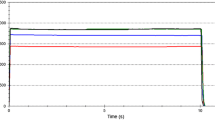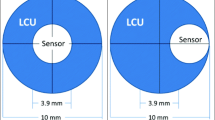Abstract
Objectives
The purpose of this study was to investigate the microhardness, polymerization shrinkage, and translucency of bulk-fill composites (BFCs) which have different light attenuation properties and filler contents.
Materials and methods
Five BFCs [Filtek Bulk Fill (FB), SureFil SDR (SS), Venus Bulk Fill (VB), SonicFill (SF), and Tetric N-Ceram Bulk Fill (TB)] and two resin-based composites (RBCs) [Tetric N-Ceram (TN) and Filtek Z350XT Flowable (ZF)] were chosen. Numbers of transmitted photons, refractive index, microhardness at different thicknesses, polymerization shrinkage, and translucency parameter (TP) were evaluated.
Results
Attenuation coefficients (ACs) based on measured photons ranged from −0.88 to −1.90. BFCs, except SF, had lower AC values than TN or ZF, and BFCs, except TN, had smaller refractive index decreases between top and bottom surfaces. Regardless of an exponential decrease in photon counts, microhardness decreased linearly as specimen thickens. Moreover, microhardness of BFCs showed smaller top-to-bottom decreases (11.5–48.8 %) than TN or ZF (57.3 and 71.5 %, respectively). BFCs with low filler contents showed lower microhardness and higher polymerization shrinkage than those of high filler contents. Also, BFCs had significantly higher (p < 0.001) TP values than TN or ZF.
Conclusion
BFCs attenuated light less than RBCs. However, some BFCs had much lower top surface microhardness and higher polymerization shrinkage than tested RBCs.
Clinical relevance
Despite the convenience of bulk filling, careful selection of BFC is advised because some BFCs have worse microhardness and polymerization shrinkage than RBCs due to their lower filler contents.




Similar content being viewed by others
References
Kemp-Scholte CM, Davidson CL (1988) Marginal sealing of curing contraction gaps in class V composite resin restorations. J Dent Res 67:841–845
Lai JH, Johnson AE (1993) Measuring polymerization shrinkage of photo-activated restorative materials by a water-filled dilatometer. Dent Mater 9:139–143
Davidson CL, Feilzer AJ (1997) Polymerization shrinkage and polymerization shrinkage stress in polymer-based restoratives. J Dent 25:435–440
Ferracane JL (2011) Resin composite-state of the art. Dent Mater 27:29–38
Park J, Chang J, Ferracane J, Lee IB (2008) How should composite be layered to reduce shrinkage stress: incremental or bulk filling? Dent Mater 24:1501–1505
Benetti AR, Havndrup-Pedersen C, Honoré D, Pedersen MK, Pallesen U (2015) Bulk-fill resin composites: polymerization contraction, depth of cure, and gap formation. Oper Dent 40:190–200
Ilie N, Stark K (2015) Effect of different curing protocols on the mechanical properties of low-viscosity bulk-fill composites. Clin Oral Investig 19:271–279
Ilie N, Stark K (2014) Curing behaviour of high-viscosity bulk-fill composites. J Dent 42:977–985
Van Ende A, De Munck J, Van Landuyt KL, Poitevin A, Peumans M, Van Meerbeek B (2013) Bulk-filling of high C-factor posterior cavities: effect on adhesion to cavity-bottom dentin. Dent Mater 29:269–277
Shortall AC, Palin WM, Burtscher P (2008) Refractive index mismatch and monomer reactivity influence composite curing depth. J Dent Res 87:84–88
Fujita K, Nishiyama N, Nemoto K, Okada T, Ikemi T (2005) Effect of base monomer’s refractive index on curing depth and polymerization conversion of photo-cured resin composites. Dent Mater J 24:403–408
Taira M, Suzuki H, Toyooka H, Yamaki M (1994) Refractive index of inorganic fillers in seven visible-light-cured composite resins. J Mater Sci Lett 13:68–70
Ilie N, Bucuta S, Draenert M (2013) Bulk-fill resin-based composites: an in vitro assessment of their mechanical performance. Oper Dent 38:618–625
Moszner N, Fischer UK, Ganster B, Liska R, Rheinberger V (2008) Benzoyl germanium derivatives as novel visible light photoinitiators for dental materials. Dent Mater 24:901–907
Behery H, El-Mowafy O, El-Badrawy W, Saleh B, Nabih S (2016) Cuspal deflection of premolars restored with bulk-fill composite resins. J Esthet Restor Dent 28:122–130
Moorthy A, Hogg CH, Dowling AH, Grufferty BF, Benetti AR, Fleming GJ (2012) Cuspal deflection and microleakage in premolar teeth restored with bulk-fill flowable resin-based composite base materials. J Dent 40:500–505
Rosatto CM, Bicalho AA, Veríssimo C, Bragança GF, Rodrigues MP, Tantbirojn D, Versluis A, Soares CJ (2015) Mechanical properties, shrinkage stress, cuspal strain and fracture resistance of molars restored with bulk-fill composites and incremental filling technique. J Dent 43:1519–1528
Leprince JG, Palin WM, Vanacker J, Sabbagh J, Devaux J, Leloup G (2014) Physico-mechanical characteristics of commercially available bulk-fill composites. J Dent 42:993–1000
Kim KH, Ong JL, Okuno O (2002) The effect of filler loading and morphology on the mechanical properties of contemporary composites. J Prosthet Dent 87:642–649
Arikawa H, Kanie T, Fujii K, Takahashi H, Ban S (2007) Effect of filler properties in composite resins on light transmittance characteristics and color. Dent Mater J 26:38–44
Emami N, Sjodahl M, Soderholm K-JM (2005) How filler properties, filler fraction, sample thickness and light source affect light attenuation in particulate filled resin composites. Dent Mater 21:721–730
Musanje L, Darvell BW (2005) Curing-light attenuation in filled-resin restorative materials. Dent Mater 22:804–817
Watts DC, Cash AJ (1994) Analysis of optical transmission by 400-500 nm visible light into aesthetic dental biomaterials. J Dent 22:112–117
Richerson DW (1982) Modern ceramic engineering. Marcel Dekker, New York
Fujita K, Ikemi T, Nishiyama N (2011) Effects of particle size of silica filler on polymerization conversion in a light-curing resin composite. Dent Mater 27:1079–1085
Hirabayashi S, Hirasawa T (1990) Improvements to light transmittance in light-cured composite resins by the utilisation of low refractive index dimethacrylates. Dent Mater J 9:203–214
Ogunyinka A, Palin WM, Shortall AC, Marquis PM (2007) Photoinitiation chemistry affects light transmission and degree of conversion of curing experimental dental resin composites. Dent Mater 23:807–813
Zorzin J, Maier E, Harre S, Fey T, Belli R, Lohbauer U, Petschelt A, Taschner M (2015) Bulk-fill resin composites: polymerization properties and extended light curing. Dent Mater 31:293–301
Gonçalves F, Kawano Y, Braga RR (2010) Contraction stress related to composite inorganic content. Dent Mater 26:704–709
Miyasaka T, Okamura H (2009) Dimensional change measurements of conventional and flowable composite resins using a laser displacement sensor. Dent Mater J 28:544–551
Salgado VE, Cavalcante LM, Silikas N, Schneider LF (2013) The influence of nanoscale inorganic content over optical and surface properties of model composites. J Dent 41:e45–e53
Author information
Authors and Affiliations
Corresponding author
Ethics declarations
Conflict of interest
All authors declare that they have no conflict of interest.
Funding
The work has no source of funding to report.
Ethical approval
This article does not contain any studies with human participants or animals performed by any of the authors.
Informed consent
For this type of study, formal consent is not required.
Rights and permissions
About this article
Cite this article
Son, SA., Park, JK., Seo, DG. et al. How light attenuation and filler content affect the microhardness and polymerization shrinkage and translucency of bulk-fill composites?. Clin Oral Invest 21, 559–565 (2017). https://doi.org/10.1007/s00784-016-1920-2
Received:
Accepted:
Published:
Issue Date:
DOI: https://doi.org/10.1007/s00784-016-1920-2




